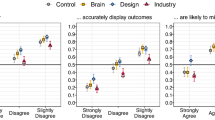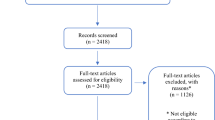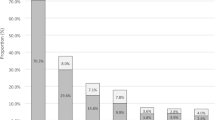Abstract
Recent empirical studies have evaluated if modifying electronic gambling machine (EGM) structural features could encourage safer gambling behaviors and decrease gambling-related problems. Several of these studies refer to Harm Reduction (HR), suggesting that the HR paradigm is useful to design, implement and test the efficacy of various prevention and treatment programs applied to EGM users. After reviewing the origins of HR and specifying its operational definition, this paper discusses the relevance of the HR framework for the study of measures related to EGM use and gambling in general. Examples are given to illustrate the arguments. The results show that HR has been over-inclusive in the field of gambling. A specific and operational definition and application of the HR framework is required for HR to be useful for the advancement of research in the gambling field.

Similar content being viewed by others
References
Adams, J. (2007). Man who left son in car at casino is sentenced. Star Tribune. Retrieved May 22, 2007, from http://www.startribune.com.
Ball, A. L. (2007). HIV, injecting drug use and harm reduction: A public health response. Addiction, 102, 684–690.
Bernhard, B. J., & Preston, F. W. (2004). On the shoulders of Merton: Potentially sobering consequences of problem gambling policy. American Behavioral Scientist, 47, 1395–1405.
Blaszczynski, A. (2002). Harm minimization strategies in gambling. An overview of international initiatives and interventions. Retrieved October 27, 2003, from http://www.austgamingcouncil.org.au/research/research.htm.
Blaszczynski, A., Ladouceur, R., & Nower, L. (2007). Self-exclusion: A proposed gateway to treatment model. International Gambling Studies, 7, 59–71.
Blaszczynski, A., Sharpe, L., & Walker, M. (2001). The assessment of the impact of the reconfiguration on electronic gaming machines as harm minimisation strategies for problem gambling. A report for the gaming industry operators group (Final report). Sydney, Australia: The University of Sydney Gambling Research Unit.
Bradley-Springer, L. (2003). Not yet ready from prime time? Safe injection facilities in the overall prevention scheme. Journal of the Association of Nurses in AIDS Care, 14(5), 71–72.
Breen, H., Buultjens, J., & Hing N. (2003). The responsible gambling code in Queensland: Implementation and venue assessment. Canberra, Australia: NAGS Conference Proceedings.
Breen, R. B., & Zimmerman, M. (2002). Rapid onset of pathological gambling in machine gambling. Journal of Gambling Studies, 18, 31–43.
Campbell, C. S. (2000). Lawlessness: Gaming policies in British Columbia, Canada. Paper presented at the meeting of the National Gambling Conference, Sydney, Australia.
Chevalier, S., Hamel, D., Ladouceur, R., Jacques, C., Allard, D., & Sévigny, S. (2004). Comportements de jeu et jeu pathologique selon le type de jeu au Québec en 2002 [Gambling behaviors and pathological gambling according to the type of game in Quebec, 2002]. Retrived October 25, 2006, from http://www.inspq.qc.ca/pdf/publications/267-ComportementsJeuQuebec2002.pdf.
Cloutier, M., Ladouceur, R., & Sévigny, S. (2006). Responsible gambling tools: Pop-up messages and pauses on video lottery terminals. Journal of Psychology, 140, 434–438.
Corporate Research Associates. (2006). Video lottery program changes. Impact analysis. Retrieved June 21, 2007, from: https://www.nsgc.ca/pdf/VLTimpactanalysisreport.pdf.
Côté, D., Caron, A., Aubert, J., Desrochers, V., & Ladouceur, R. (2003). Near wins prolong gambling on a video lottery terminal. Journal of Gambling Studies, 19, 433–438.
Courtney, K. A. (2002). Unattended children in casinos—Whose responsibility? Gaming Law Review, 6, 101–106.
Dickerson, M., Hinchy, J., England, S. L., Fabre, J., & Cunningham, R. (1992). On the determinants of persistent gambling behaviour. I. High-frequency poker machine players. British Journal of Psychology, 83, 237–248.
Doiron, J. P., & Nicki, R. M. (2001). Epidemiology of problem gambling in Prince Edward Island: A Canadian microcosm? Canadian Journal of Psychiatry, 46, 413–417.
Doiron, J. P. (2006). Gambling and problem gambling in Prince Edward Island. Retrieved December 10, 2006, from http://www.gov.pe.ca/photos/original/doh_GambReport.pdf.
Dowling, N., Smith, D., & Thomas, T. (2005). Electronic gaming machines: Are they the “crack-cocaine” of gambling? Addiction, 100, 33–45.
Drucker, E. (2005). Witch-hunt. Harm Reduction Journal, 2(3). Retrieved May 10, 2007, from http://www.harmreductionjournal.com/content/2/1/3.
Duncan, D. F., Nicholson, T., Clifford, P., Hawkins, W., & Petosa, R. (1994). Harm reduction: An emerging new paradigm for drug education. Journal of Drug Education, 24, 281–290.
Erickson, P. G. (1999). Introduction: The three phases of harm reduction. An examination of emerging concepts, methodologies, and critiques. Substance Use & Misuse, 34, 1–7.
Finney, J. W., & Moos, R. H. (2006). Matching clients’ treatment goals with treatment oriented towards abstinence, moderation or harm reduction. Addiction, 101, 1540–1542.
Gilliland, J. A., & Ross, N. A. (2005). Opportunities for video lottery terminal gambling in Montréal: An environmental analysis. Canadian Journal of Public Health, 96, 55–59.
Götestam, K., & Johansson, A. (2003). Characteristics of gambling and problematic gambling in the Norwegian context. A DSM-IV-based telephone interview study. Addictive Behaviors, 28, 189–197.
Hall, W. (2007). What’s in a name? [commentary]. Addiction, 102, 692.
Harper, T. (2003). Smoking and gambling: A trance inducing ritual. Tobacco Control, 12, 231–233.
Hing, N. (2003). An assessment of member awareness, perceived adequacy and perceived effectiveness of responsible gambling strategies in Sydney Clubs. Lismore, Australia: Southern Cross University, Centre for Gambling Education and Research.
Human Services Administration of Lincoln. (2004). Socioeconomic indicators of legalized gambling in Lincoln/Lancaster County, Nebraska. Lancaster County, NE: Joint Budget Committee.
International Harm Reduction Association. What is harm reduction? Retrieved March 29, 2006 from http://www.ihra.net.
Julien, E., & Desenclos, J.-C. (2005). Harm reduction interventions, behaviours and associated health outcomes in France, 1996–2003. Addiction, 100, 1690–1700.
Kassinove, J. I., & Schare, M. L. (2001). Effects of the “near miss” and the “big win” on persistence at slot machine gambling. Psychology of Addictive Behaviors, 15, 155–158.
Koch, E. (2005). Deadly lapse of memory. Kids in cars: An ongoing investigation. Las Vegas Sun. Retrieved May 22, 2007, from http://www.lasvegassun.com.
Ladouceur, R., Jacques, C., Sévigny, S., & Cantinotti, M. (2005). Impact of the format, arrangement and availability of electronic gaming machines outside casinos. International Gambling Studies, 5, 139–154.
Ladouceur, R., Jacques, C., Giroux, I., Ferland, F., & Leblond, J. (2000). Analysis of a casino’s self-exclusion program. Journal of Gambling Studies, 16, 453–460.
Ladouceur, R., & Sévigny, S. (2002). Symbols presentation modality as a determinant of gambling behavior. Journal of Psychology, 136, 443–448.
Ladouceur, R., & Sévigny, S. (2003). Interactive messages on video lottery terminals and the persistence to gamble. Gambling Research, 15, 45–50.
Ladouceur, R., & Sévigny, S. (2005). Structural characteristics of video lotteries: Effects of a stopping device on illusion of control and gambling persistence. Journal of Gambling Studies, 21, 117–131.
Ladouceur, R., & Sévigny, S. (2006). The impact of video lottery game speed on gamblers. Journal of Gambling Issues, 17. Retrieved September 5, 2006, from http://www.camh.net/egambling/issue17/ladouceur.html.
Lafortune, D., & Kiely, M. C. (1989). Prévention primaire des psychopathologies: Appellation contrôlée [Primary prevention of psychopathology: A licensed terminology]. Santé Mentale au Québec, 14, 54–68.
Lavoie, M., Godin, G., & Valois, P. (1999). Understanding the use of a community-based drive-home service after alcohol consumption among young adults. Journal of Community Health, 24, 171–186.
Legislative Assembly of Manitoba. (1995). First session of the thirty-sixth legislature (Volume 19, Committee of Supply—Department of Family Services). Retrieved May 17, 2007, from http://www.gov.mb.ca/hansard/hansard/1st-36th/vol19/h019_4.html.
Lenton, S., & Single, S. (1998). The definition of harm reduction. Drug and Alcohol Review, 17, 213–220.
Lesieur, H. R., & Rothschild, J. (1989). Children of gamblers anonymous members. Journal of Gambling Behavior, 59, 269–281.
Loba, P., Stewart, S. H., Klein, R. M., & Blackburn, J. R. (2001). Manipulations of the features of standard video lottery terminal (VLT) games: Effects in pathological and non-pathological gamblers. Journal of Gambling Studies, 17, 297–320.
Loxley, W. (2000). Doing the possible: Harm reduction, injecting drug use and blood borne viral infection in Australia. International Journal of Drug policy, 11, 407–416.
Lund, I. (2006). Gambling and problem gambling in Norway: What part does the gambling machine play? Addiction Research and Theory, 14, 475–491.
MacCoun, R. J. (1998). Toward a psychology of harm reduction. American Psychologist, 53, 1199–1208.
MacMaster, S. A. (2004). Harm reduction: A new perspective on substance abuse services. Social Work, 49, 356–363.
Marlatt, A. G. (1996). Harm reduction: Come as you are. Addictive Behaviors, 21, 779–788.
Marshall, D. C., & Baker, R. G. V. (2001). Clubs, spades, diamonds and disadvantages: The geography of electronic gaming machines in Melbourne. Australian Geographical Studies, 39, 17–33.
Marshall, D., McMillen, J., Niemeyer, S., & Doran, B. (2004). Gaming machine accessibility and use in suburban Canberra: A detailed analysis of the Tuggeranong valley. Canberra: ANU Centre for Gambling.
McLaren, C., Null, J., & Quinn, J. (2005). Heat stress from enclosed vehicles: Moderate ambient temperatures cause significant temperature rise in enclosed vehicles. Pediatrics, 116, 109–112.
McMillen, J., & Pitt, S. (2005). Review of the ACT government’s harm minimisation measures. Canberra, Australia: Centre for Gambling Research. Retrieved November 5, 2006, from http://gambling.anu.edu.au/menu/PDFs/Policy%20Review-Final-withISBN.pdf.
McMullan, J., & Perrier, D. (2007). The security of gambling and gambling with security: Hacking, law enforcement and public policy. International Gambling Studies, 7, 43–58.
Ministry of Public Safety and Sollicitor General. (2003). Advertising and marketing standards for the B. C. gambling industry. Retrieved June 19, 2007, from http://www.pssg.gov.bc.ca/gaming/legislation-policies/docs/stds-advertising-marketing.pdf.
Morgan, T., Kofoed, L., Buchkoski, J., & Carr, R. D. (1996). Video lottery gambling: Effects on pathological gamblers seeking treatment in South Dakota. Journal of Gambling Studies, 12, 451–460.
Muelleman, R. L., DenOtter, T., Wadman, M. C., Tran, T. P., & Anderson, J. (2002). Problem gambling in the partner of the emergency department patient as a risk factor for intimate partner violence. Journal of Emergency Medicine, 23, 307–312.
Nowatzki, N. R., & Williams, R. J. (2002). Casino self-exclusion programmes: A review of the issues. International Gambling Studies, 2, 3–25.
Nower, L., & Blaszczynski, A. (2006). Characteristics and gender differences among self-excluded casino problem gamblers: Missouri data. Journal of Gambling Studies, 22, 81–99.
O’Boyle, T. (2006). The illegal use of video poker machines by public bars and private social clubs in Pennsylvania: It’s a rational choice. Journal of Economic Crime Management, 4(1). Retrieved May 16, 2007, from www.jecm.org.
O’Hare, P. (2007). Merseyside, the first harm reduction conferences, and the early history of harm reduction. International Journal of Drug Policy, 18, 141–144.
Omnifact Bristol Research. (2007). Nova Scotia player card research project (Stage III research report). Retrieved June 19, 2007, from http://www.nsgc.ca/pdf/Omnifacts%20Bristol%20Research%20Report.pdf.
Parascandola, M. (2005). Science, industry, and tobacco harm reduction: A case study of tobacco industry scientist’ involvement in the National cancer institute’s smoking and helath program, 1964–1980. Public Health Reports, 120, 338–349.
Paré, R., & Rousselle, C. (2007, June). L’intervention de crise au casino de Montréal [Crisis intervention at the Montreal casino]. Poster presented at the Colloque francophone « Les multiples facettes du jeu », Québec, Canada.
Quinn, F. L. (2001). First do not harm: What could be done by casinos to limit pathological gambling. Managerial and Decision Economics, 22, 133–142.
Quinn, J. P. (1969). Gambling and gambling devices. In Patterson Smith reprint series in criminology, law enforcement, and social problems: Vol. 48. Montclair, NJ: Patterson Smith Publishing Corporation. (Originally published 1912).
Problem Gambling Foundation of New Zealand. (2006). Family violence and gambling. Retrieved May 17, 2007, from http://www.cgs.co.nz/files/domestic_violence_and_gambling(2)sept06.pdf.
Régie des alcools, des courses et des jeux. (2004). Alcohol: Public messages. Retrieved February 3, 2007, from http://www.racj.gouv.qc.ca.
Rekart, M. (2005). Sex-work harm reduction. Lancet, 366, 2123–2134.
Riga, A., & Authier, P. (2006, October 25). Smokes ban hits loto-Quebec. The Montreal Gazette. Retrieved November 15, 2006, from http://www.canada.com/montrealgazette.
Ritter, A., & Cameron, J. (2005). Monograph No. 06: A systematic review of harm reduction (DPMP Monograph Series). Fitzroy, Australia: Turning Point Alcohol and Drug Centre.
Roberts, A. R., & Yeager, K. R. (2005). Lethality assessment and crisis intervention with persons presenting with suicidal ideation. In A. R. Roberts (Ed.), Crisis intervention handbook: Assessment, treatment, and research (3rd ed., pp. 35–63). Oxford: Oxford University Press.
Robson, G., & Marlatt, G. A. (2006). Harm reduction and alcohol policy [Editorial]. International Journal of Drug policy, 17, 255–257.
Rodda, S., & Cowie, M. (2005). Evaluation of electronic gaming machine harm minimization measures in Victoria (final report). Melbourne, Australia: Office of Gaming and Racing, Victorian Government Department of Justice.
Rose, N. (2003a). Status of Gambling Laws. Gaming Law Review, 7, 1–13.
Rose, N. (2003b). Underage gambling and the law. In H. J. Shaffer, M. N. Hall, J. Vander Bilt, & E. George (Eds.), Futures at stake: Youth, gambling and society (pp. 126–189). Reno, NV: University of Nevada Press.
Sadinsky, S. (2005). Review of the problem-gambling and responsible-gaming strategy of the Government of Ontario. Retrieved June 1, 2007, from http://health.gov.on.ca/english/public/pub/ministry_reports/gambling_05/sadinsky.pdf.
Schellinck, T., & Schrans, T. (2002). Atlantic Lottery Corporation video lottery responsible gaming feature research (Final report). Halifax, NS: Focal Research Consultants Ltd. Retrieved February 20, 2003, from http://www.gamingcorp.ns.ca/responsible/pbrgf.htm.
Schrans, T., Grace, J., & Schellinck, T. (2004). 2003 NS VL Responsible Gaming Features Evaluation (Final report). Halifax, NS: Focal Research Consultants Ltd. Retrieved December 21, 2004, from http://www.gamingcorp.ns.ca/pdf/2003-NS-VL-RGF-Nov9–2004.pdf.
Sharpe, L., Walker, M., Coughlan, M.-J., Enersen, K., & Blaszczynski, A. (2005). Structural changes to electronic gaming machines as effective harm minimization strategies for non-problem and problem gamblers. Journal of Gambling Studies, 21, 503–520.
Smith, G. J., & Wynne, H. J. (2002). Measuring gambling and problem gambling in Alberta. Edmonton, AB: Alberta Gaming Research Institute. Retrieved December 10, 2006, from: https://dspace.ucalgary.ca/bitstream/1880/1626/1/gambling_alberta_cpgi.pdf.
Smith, G. J., & Wynne, H. J. (2004). VLT gambling in Alberta: A preliminary analysis (Final report). Edmonton, AB: Alberta Gaming Research Institute and University of Alberta. Retrieved November 10, 2004, from http://www.uofaweb.ualberta.ca/abgaminginstitute//pdfs/VLT_Gambling_Alberta.pdf.
Sobell, M. B., & Sobell, L. C. (1995). Controlled drinking after 25 years: How important was the great debate? Addiction, 90, 1149–1153.
Stafford, N. (2007). Using words: The harm reduction conception of drug use and drug users. International Journal of Drug Policy, 18, 88–91.
Stewart, S. H., Peterson, J.B., Collins, P., Eisnor, S., & Ellery, M. (2006). Heart rate increase to alcohol administration and video lottery terminal play among probable pathological gamblers and nonpathological gamblers. Psychology of Addictive Behaviors, 20, 53–61.
Stimson, G. V. (2007). “Harm reduction—Coming of an age”: A local movement with global impact. International Journal of Drug Policy, 18, 67–69.
Stockwell, T. (2001). Harm reduction, drinking patterns and the NHMRC drinking guidelines. Drugs and Alcohol Review, 20, 121–129.
Stockwell, T. (2006). Alcohol supply, demand, and harm reduction: What is the strongest cocktail? International Journal of Drug Policy, 17, 269–277.
Tammi, T. (2004). The harm-reduction school of thought: Three fractions. Contemporary Drug Problems, 31, 381–399.
Tammi, T. (2005). Discipline or contain? The struggle over the concept of harm reduction in the 1997 Drug Policy Committee in Finland. International Journal of Drug Policy, 16, 384–392.
Thomson, G., & Wilson, N. (2006). One year of smokefree bars and restaurants in New Zealand: Impacts and responses. BMC Public Health, 6(64), Retrieved October 1, 2006, from http://dx.doi.org/10.1186/1471–2458–6-64.
Valenzuela, T. D., Roe, D. J., Nichol, G., Clark, L. L., Spaite, D. W., & Hardman, R. G. (2000). Outcomes of rapid defibrillation by security officers after cardiac arrest in casinos. New England Journal of Medicine, 343, 1206–1209.
Volberg, R. A. (2003). Gambling and problem gambling in Arizona. Northampton, MA: Gemini Research. Retrieved December 10, 2006, from http://www.problemgambling.az.gov/prevalencestudy.pdf.
Walker, M. B. (1992). The psychology of gambling. Sydney, Australia: Pergamon Press.
World Health Organization. (1994). Lexicon of alcohol and drug terms published by the World Health Organization [Electronic version]. Retrieved January 13, 2006, from http://www.who.int/substance_abuse/terminology/who_lexicon/en.
Acknowledgement
Many thanks to Christian Jacques who challenged our views of harm reduction. His insight substantially improved the quality of our paper.
Author information
Authors and Affiliations
Corresponding author
Additional information
Disclosure: At the time of the study, Michael Cantinotti held a scholarship from the Loterie Romande (public-benefit lottery in Switzerland) for his doctoral studies. This study was funded by the Fonds pour la prévention et le traitement du jeu of the Fondation de l’Université Laval. During the study, the Centre québécois d’excellence pour la prévention et le traitement du jeu received financial support from the Ministère de la Santé et des Services Sociaux du Québec, the Fonds Québécois de la Recherche pour la Santé et la Culture, Loto-Québec, the Ontario Problem Gambling Research Center, and Harrah’s Operating Funds.
Rights and permissions
About this article
Cite this article
Cantinotti, M., Ladouceur, R. Harm Reduction and Electronic Gambling Machines: Does this Pair Make a Happy Couple or is Divorce Foreseen?. J Gambl Stud 24, 39–54 (2008). https://doi.org/10.1007/s10899-007-9072-6
Received:
Accepted:
Published:
Issue Date:
DOI: https://doi.org/10.1007/s10899-007-9072-6




